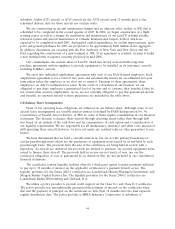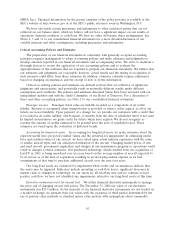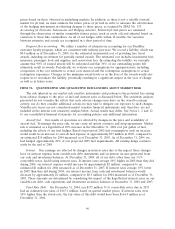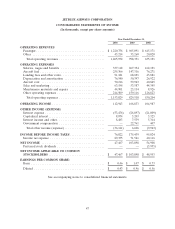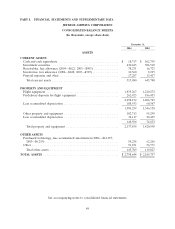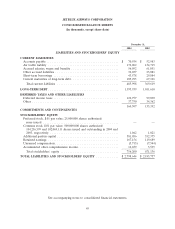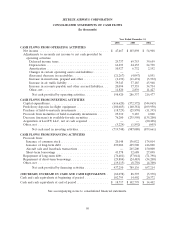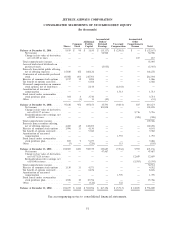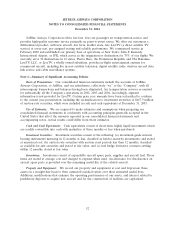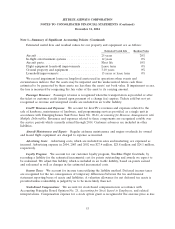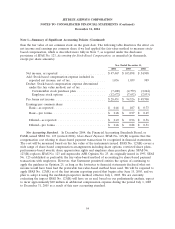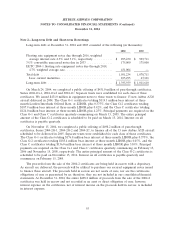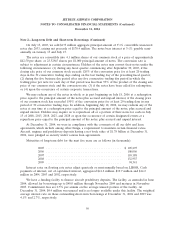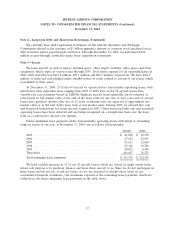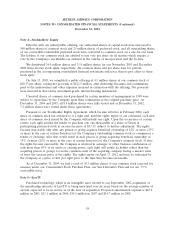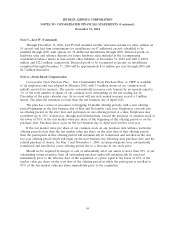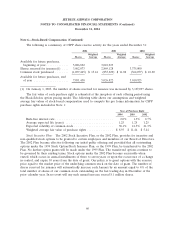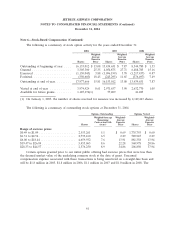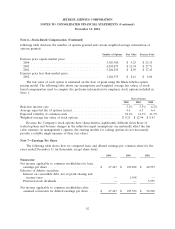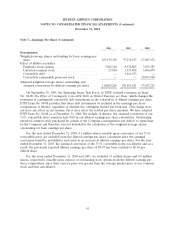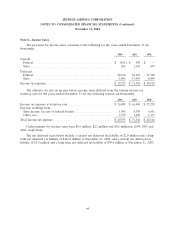JetBlue Airlines 2004 Annual Report Download - page 62
Download and view the complete annual report
Please find page 62 of the 2004 JetBlue Airlines annual report below. You can navigate through the pages in the report by either clicking on the pages listed below, or by using the keyword search tool below to find specific information within the annual report.
JETBLUE AIRWAYS CORPORATION
NOTES TO CONSOLIDATED FINANCIAL STATEMENTS (Continued)
December 31, 2004
Note 1—Summary of Significant Accounting Policies (Continued)
than the fair value of our common stock on the grant date. The following table illustrates the effect on
net income and earnings per common share if we had applied the fair value method to measure stock-
based compensation, which is described more fully in Note 7, as required under the disclosure
provisions of SFAS No. 123, Accounting for Stock-Based Compensation, as amended (in thousands,
except per share amounts):
Year Ended December 31,
2004 2003 2002
Net income, as reported .......................... $47,467 $ 103,898 $ 54,908
Add: Stock-based compensation expense included in
reported net income, net of tax .................... 1,056 1,039 989
Deduct: Stock-based compensation expense determined
under the fair value method, net of tax ..............
Crewmember stock purchase plan ................ (7,400) (2,759) (3,264)
Employee stock options ....................... (12,672) (7,652) (2,933)
Pro forma net income ............................ $28,451 $ 94,526 $ 49,700
Earnings per common share:
Basic—as reported ............................. $ 0.46 $ 1.07 $ 0.73
Basic—pro forma .............................. $ 0.28 $ 0.97 $ 0.65
Diluted—as reported ........................... $ 0.43 $ 0.96 $ 0.56
Diluted—pro forma ............................ $ 0.26 $ 0.88 $ 0.51
New Accounting Standard. In December 2004, the Financial Accounting Standards Board, or
FASB, issued SFAS No. 123 (revised 2004), Share-Based Payment. SFAS No. 123(R) requires that the
compensation cost relating to share-based payment transactions be recognized in financial statements.
The cost will be measured based on the fair value of the instruments issued. SFAS No. 123(R) covers a
wide range of share-based compensation arrangements including share options, restricted share plans,
performance-based awards, share appreciation rights and employee share purchase plans. SFAS No.
123(R) replaces SFAS No. 123 and supersedes APB Opinion No. 25. As originally issued in 1995, SFAS
No. 123 established as preferable the fair-value-based method of accounting for share-based payment
transactions with employees. However, that Statement permitted entities the option of continuing to
apply the guidance in Opinion 25, as long as the footnotes to financial statements disclosed what net
income would have been had the preferable fair-value-based method been used. We will be required to
apply SFAS No. 123(R) as of the first interim reporting period that begins after June 15, 2005, and we
plan to adopt it using the modified-prospective method, effective July 1, 2005. We are currently
evaluating the impact SFAS No. 123(R) will have on us and, based on our preliminarily analysis, expect
to incur approximately $20 million in additional compensation expense during the period July 1, 2005
to December 31, 2005 as a result of this new accounting standard.
54


